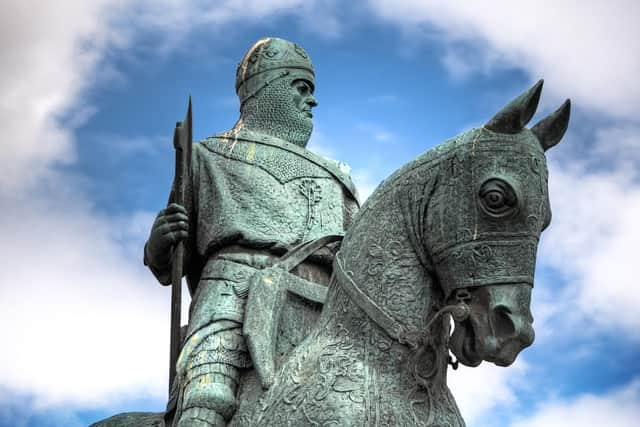Robert the Bruce: DNA breakthrough in search for descendants of King of Scots
Researchers from the University of Strathclyde have found the marker in male line descendants of the Bruces of Clackmannan, who were related to Robert the Bruce, King of Scots from 1306 to 1329.
The breakthrough means that anyone who tests positive for the marker is descended from the same family as the King.
Advertisement
Hide AdAdvertisement
Hide AdRollo Bruce, a retired textile research editor from Oxford, is one of those descendants who has taken a test and whose genes have the unique marker, which is now named FTB15831.


Graham Holton, principle tutor on the university’s genealogical studies postgraduate programme, said: “Y chromosome DNA tests taken by male line descendants of two of Robert of Clackmannan’s sons, Robert and Edward, show that they both carry the marker FTB15831.
“This means it may also have been carried by their close relative, King Robert.
“This discovery means that anyone living today who tests positive for the marker is descended from the same family as the famous king.”
Although there are varying theories about the exact relationship between the Bruces of Clackmannan and Robert the Bruce, there is a consensus that the link was very close.
In the Register of the Great Seal for 1365, a charter of King David II of Scotland, lands in Clackmannan were granted to Robert Bruce, who is described in the document in Latin as “our beloved and faithful kinsman”.
This Robert is first mentioned in 1360 as the young heir of his father, Thomas Bruce.
Mr Holton said: “Although the test takers from both lines carry FTB15831, one of them also has an additional genetic marker, indicating his descent from Robert Bruce, 3rd Baron of Clackmannan, who died around 1405.
Advertisement
Hide AdAdvertisement
Hide Ad“Further research may reveal more markers for specific branches of the Bruce family.
“This discovery will also allow the comparison of these results with any Y-DNA which can be extracted from supposed remains of King Robert, and thus confirm the true identity.”
Robert the Bruce was born on 11 July 1274, likely at Turnberry Castle in Ayrshire. His father’s side has its roots in Normandy and his mother, Marjorie, was the Countess of Carrick and descended from an ancient Gaelic bloodline.
Robert rose to prominence after the death of Alexander III in 1296, when there was no direct heir to take the Crown.
King Edward I chose John Balliol as King, with Robert the Bruce’s grandfather, Robert de Brus, 5th Lord of Annandale, cast aside from the throne.
What followed was years of power struggle and switching loyalties as Robert the Bruce pursued his campaign for the Crown.
Robert the Bruce, whose coronation was held at Scone in 1306, defeated England’s King Edward II at the Battle of Bannockburn in 1314, freeing Scotland from English rule until the countries were united by the Act of Union in 1707.
The team at Strathclyde University have long been interested in untangling the Bruce line.
Advertisement
Hide AdAdvertisement
Hide AdIn 2016, the found another genetic marker from the descendants of Robert III, the great grandson of the first King of Scots.
The research was able to place Glasgow businessman Shaw Stewart and retired engineer Donald Stewart, of Lanark, in the family line of Robert III.
A message from the Editor:Thank you for reading this article. We're more reliant on your support than ever as the shift in consumer habits brought about by Coronavirus impacts our advertisers.
If you haven't already, please consider supporting our trusted, fact-checked journalism by taking out a digital subscription.
Comments
Want to join the conversation? Please or to comment on this article.